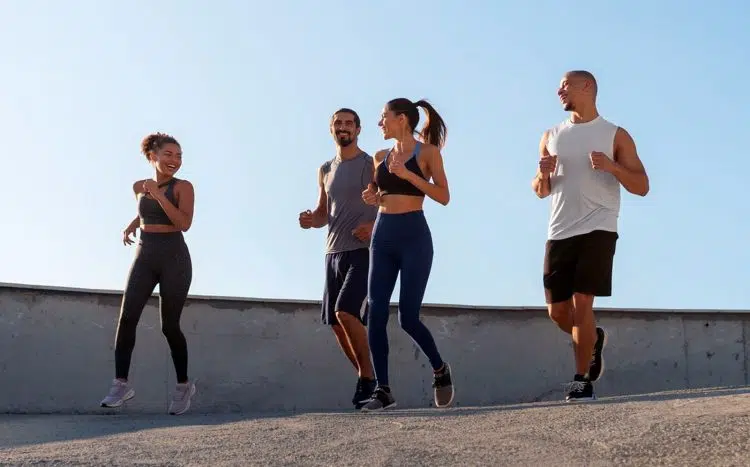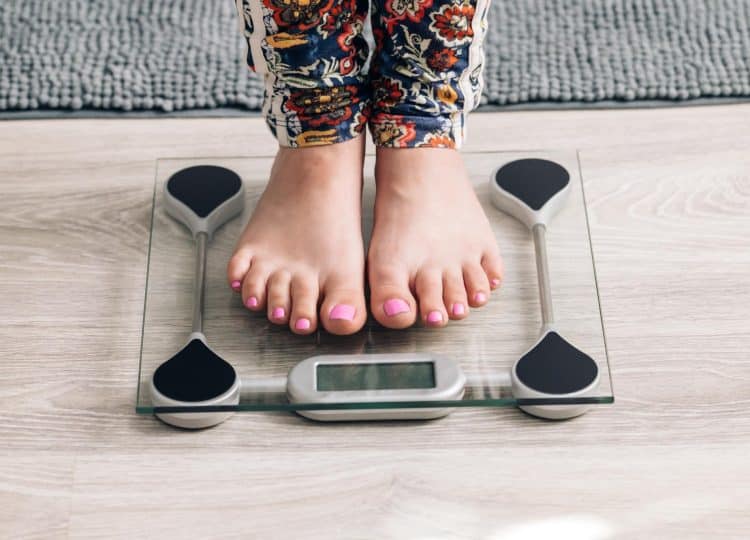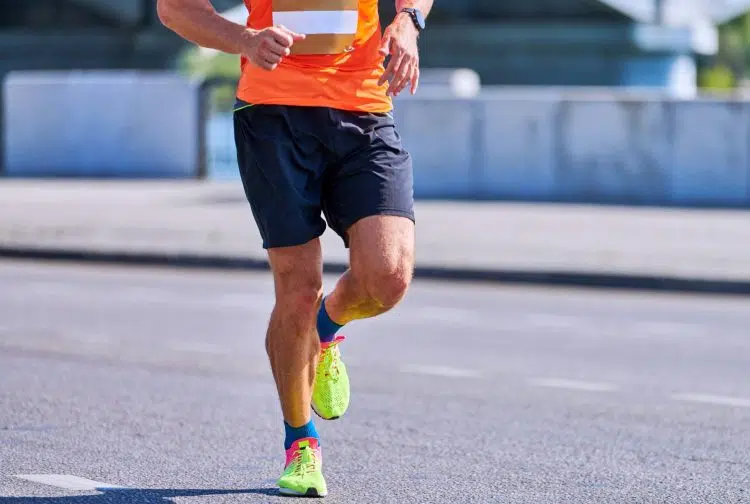Consistently shaking up your training regime is the only way to make consistent progress. As a personal trainer with over 17 years of experience, I’m often asked about the best way to break through plateaus. “Flip your training” is my usual answer.
To be completely honest, I have been dealing with a plateau of my own. My one-mile pace hit an upper ceiling, and I was looking for ways to conquer it. As chance would have it, I stumbled upon a social media post by a fitness influencer about how backward running unlocked new running PRs for him.
This, along with its potential benefits of improved posture and leg strength, intrigued me immensely. I decided to take up backward running as a 30-day challenge to determine if it holds water.
In this article, I share everything you need to know about backward running, including the scientific evidence of its benefits, programming tips, and precautions.
Science Behind Backward Running
Backward running isn’t a fad and is backed by solid science. Here are all the benefits you need to know about:
Level Up Your Fitness: Join our 💪 strong community in Fitness Volt Newsletter. Get daily inspiration, expert-backed workouts, nutrition tips, the latest in strength sports, and the support you need to reach your goals. Subscribe for free!
Biomechanics
Running forward puts most of the demand on your quads and calves. However, running backward shifts the focus to the hamstrings, giving your quads a much-needed breather. This can be especially helpful for folks with quad-dominant running styles or those prone to knee pain.
A study found that six weeks of a back walking program compared with forward walking resulted in a greater reduction in pain and functional disability. It also improved quadriceps muscle strength and performance in individuals with knee osteoarthritis. (1)
Plus, instead of your calves and shins absorbing impact, backward running leads to greater tibialis anterior engagement, potentially strengthening this often-overlooked muscle.
Posture and Core
Many of my personal training clients tend to lean forward during traditional running workouts, especially when fatigue starts to set in. However, backward running forces you to stay upright to maintain balance. It helps improve overall balance and coordination and builds core strength.
Rehabilitation
According to a study, running backward can boost isometric and concentric muscle action of the vastus medialis oblique and vastus lateralis and may be useful in clinical conditions that require an increase in knee extensor strength (2). This is great news for people undergoing knee rehabilitation.
Improves Forward Running Economy & Cardiorespiratory Fitness
Research suggests that five weeks of backward running training can improve forward running economy in healthy, trained male runners without altering VO2 max or body composition. (3)(4)
Runners with better running economy can run faster for longer distances because they’re more economical with their oxygen and can produce more force for longer.
Higher Calorie Burn & Cardiopulmonary Response
It has been found that backward running requires approximately 30 percent more metabolic energy expenditure than forward running. (5) Furthermore, backward locomotion elicits a greater metabolic demand and cardiopulmonary response than forward locomotion. (6)
“Backward walking can help strengthen legs and improve knee health and has helped me get off painkillers and strengthen my knees. It is also an excellent form of cardio. You can get a potent cardio workout by going faster or alternating with forward walking,” says Ben Patrick of the Knees Over Toes Guy fame.
I hope this information is enough to convince you to make backward running an indispensable part of your training regime.
My 4-Week Backward Running Experiment
I’ll be honest: The first time I tried backward running, I felt a bit like a penguin waddling in reverse. I felt uncoordinated and awkward. But remember, every fitness journey starts with a single step, albeit a little wobbly.
Here is my experience with this training routine:
Week 1: The Penguin Shuffle
After I tried to bite off more than I could chew, I took a step back (pun intended) and began with backward walking instead of running. After a 15-minute retro walk, my lower legs were pumped, and I’m pretty sure people in my local park questioned my training principles — and sanity.
I switched to a backward jog on the fourth day of training, and I can attest that it is a whole new ball game in itself.
Make no mistake, walking backward in a straight line is like walking a tightrope after a double espresso. You are too confident in your abilities but lack the skill. My running form felt completely alien in reverse.
I also used the treadmill in my gym for controlled workouts to check my form and build confidence.
Level Up Your Fitness: Join our 💪 strong community in Fitness Volt Newsletter. Get daily inspiration, expert-backed workouts, nutrition tips, the latest in strength sports, and the support you need to reach your goals. Subscribe for free!
Weeks 2-4: Finding My Backwards Groove
I finally got into a groove in the second week; my calves adapted, my coordination improved, and I even managed to increase my speed.
For the first time ever, I ended a running workout with pumped-up hamstrings. I also realized that backward running demanded much greater focus, which ensures your brain doesn’t go into an overdrive mode during the workout, which is usually the case with forward running.
How to Get Started with Backward Running: A Beginner’s Guide
So, are you ready to flip the script on your cardio? You must keep the following factors in mind while starting this new training regime:
Safety First
You shouldn’t expect to sprint in reverse right from your first workout. It is much more challenging than it looks, believe me. Begin with a walk before graduating to a slow jog, or get used to the movement.
Choose a safe, flat surface with no obstacles to start your backward running journey. Don’t rush to uphill backward walks, as this can increase the risk of injury. Also, avoid crowded areas where you might collide with others.
I recommend that my clients avoid their nearby parks if they are crowded. Driving to a less crowded park is well worth it.
Also, people dealing with knee, hip, or ankle issues must consult their doctor or physical therapist before attempting backward running.
Pro Tip: Have a friend or your significant other act as a spotter and alert you to any obstacles, especially when starting.
Mastering Proper Technique
Retro running requires you to learn and unlearn several things, and it involves a much different form than conventional forward running. Here’s a lowdown on the things you must consider:
Keep your head up and scapula pulled back and down throughout the workout. Make sure you’re looking straight ahead and not down at your feet, as it can throw you off balance, resulting in a fall.
Start with small, controlled steps and focus on pushing off with the balls of your feet, not your heels. Another great thing about this running technique is that it reduces lower-body joint strain since you’ll be landing on the balls of your feet.
Keep your arms relaxed and swing them naturally at your sides as you would during forward running. Also, regularly glance over your shoulders to check for obstacles. There are no brownie points for going blind here.
Sample Back Running Training Plan
Use the following blueprint to kickstart your backward running journey:
- Week One: Two to three sessions of five to 10 minutes. Mix them with regular forward running of the same duration.
- Week Two: Increase to three to four sessions, with 10 to 15 minutes of back running.
- Week Three: Incorporate short backward sprints of 10 to 20 seconds during the 10 to 15-minute session.
- Week Four and Beyond: Gradually increase the duration and intensity of your backward running workout based on your fitness levels and training objectives.
Pro Tip: Some people might experience hamstring strain while transitioning to higher-intensity workouts. Learn to listen to your body and pull back when necessary.
Is Backward Running Right for You?
Here’s who all can benefit from backward running:
- People trying to improve their posture.
- Athletes can use backward running to build strength, improve coordination, and bulletproof their joints.
- Running can get boring quickly, and backward running can add a dose of fun and novelty to your workouts.
Alternatives and Variations To Backward Running
Retro running might not be for everyone, but that is absolutely fine. Here are some other ways to get similar benefits:
- Backward Walking: I recommend everyone start with backward walking before moving to running.
- Treadmill Backward Walk: Some people are not comfortable with the idea of walking backward in open space. For them, I suggest walking backward on a treadmill. However, do so with the treadmill turned off while holding the side rails for better knees and hamstring stimulation.
- Backward Lunges: This strength training exercise works similar muscles and can boost your balance and coordination.
As awesome as backward running is, they should complement your forward running. Balance the two to get the best bang for your buck.
Conclusion
Running backward can be incredibly effective for improving your cardiovascular health, balance, coordination, and forward running abilities. I highly recommend runners dealing with a rut add a 10-minute backward running session to their regime to experience the benefits of this technique.
Now that you know everything about backward running, are you ready to turn your workouts around — literally?
If you have any questions about backward running or need help implementing it into your workouts, please comment below, and I’ll be happy to help!
References:
- Alghadir AH, Anwer S, Sarkar B, Paul AK, Anwar D. Effect of 6-week retro or forward walking program on pain, functional disability, quadriceps muscle strength, and performance in individuals with knee osteoarthritis: a randomized controlled trial (retro-walking trial). BMC Musculoskelet Disord. 2019;20(1):159. Published 2019 Apr 9. doi:10.1186/s12891-019-2537-9
- Flynn, T. W., & Soutas-Little, R. W. (1993). Mechanical power and muscle action during forward and backward running. The Journal of orthopaedic and sports physical therapy, 17(2), 108–112. https://doi.org/10.2519/jospt.1993.17.2.108
- Ordway, J. D., Laubach, L. L., Vanderburgh, P. M., & Jackson, K. J. (2016). The Effects of Backwards Running Training on Forward Running Economy in Trained Males. Journal of strength and conditioning research, 30(3), 763–767. https://doi.org/10.1519/JSC.0000000000001153
- Terblanche, E., Page, C., Kroff, J., & Venter, R. E. (2005). The effect of backward locomotion training on the body composition and cardiorespiratory fitness of young women. International journal of sports medicine, 26(3), 214–219. https://doi.org/10.1055/s-2004-820997
- Cavagna GA, Legramandi MA, La Torre A. Running backwards: soft landing-hard takeoff, a less efficient rebound. Proc Biol Sci. 2011;278(1704):339-346. doi:10.1098/rspb.2010.1212
- Flynn, T. W., Connery, S. M., Smutok, M. A., Zeballos, R. J., & Weisman, I. M. (1994). Comparison of cardiopulmonary responses to forward and backward walking and running. Medicine and science in sports and exercise, 26(1), 89–94.











